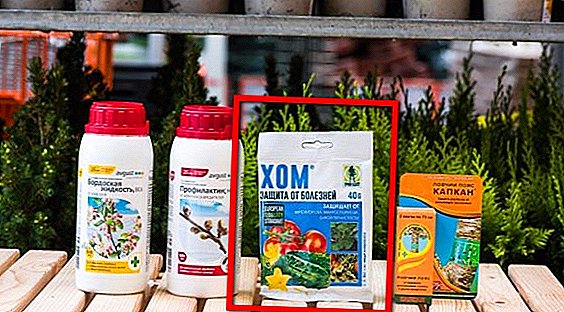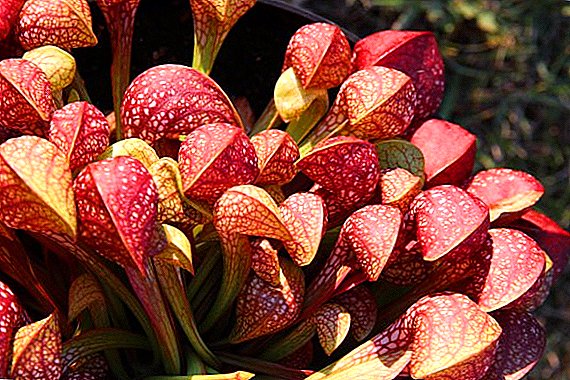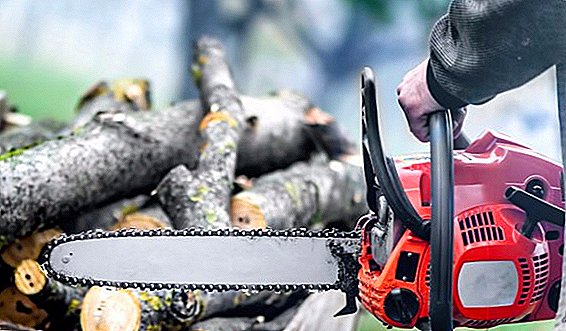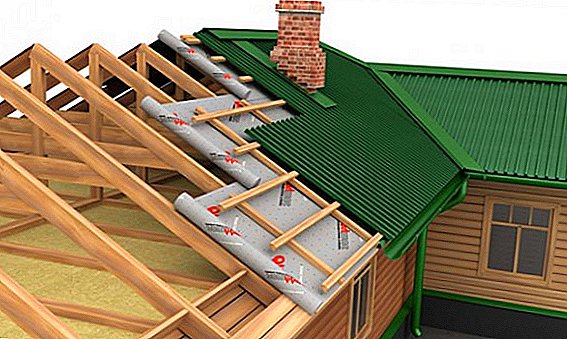 Attic - this is a cozy room, which is located directly under the roof, that is, in fact, is a residential attic. Today it is increasingly used in the construction of country houses and cottages. However, when using the attic as a living room, it should be borne in mind that high-quality roof insulation will be required, as it may be too cool and humid in the winter and very hot in the summer. Tips on how to make the insulation itself, you will find in our material.
Attic - this is a cozy room, which is located directly under the roof, that is, in fact, is a residential attic. Today it is increasingly used in the construction of country houses and cottages. However, when using the attic as a living room, it should be borne in mind that high-quality roof insulation will be required, as it may be too cool and humid in the winter and very hot in the summer. Tips on how to make the insulation itself, you will find in our material.
Mansard roof cake
Insulation of the roof in a house with an attic should solve two main tasks:
- Do not let the air get too hot in hot weather.
- Effectively keep warm in winter.

However, in order to create a comfortable environment when living in the attic space, it is necessary to figure out how the roof is mounted and what the so-called roofing pie consists of. The creation of this multi-layer construction is the work of professional builders. It is important for us to understand how the roof is arranged, what is the role of each of its layers, and what materials best cope with the task.
We recommend to learn how to make a mansard, dvukhskatnuyu and chetyrehskatnuyu roof with your own hands
The multi-layer rooftop pie consists of several essential components, each of which has a specific purpose. If we consider it, starting from the inside, the sequence of the layers will be as follows:
- Vapor barrier - a thin membrane, which is designed to protect the insulation from moisture from the room and continue the service life of roofing materials. It is made of a special three-layer film reinforced with a polymer frame. It may have a foil layer to reduce heat loss. Steam insulation material is attached to the rafters.
- Heater. Plays a major role in thermal insulation. By holding the air, it retains heat. It can be made of various materials: glass and stone wool, polystyrene foam, foam plastic, polyurethane, foam rubber, rubber, cork sheet.
- Ventilation clearance - insulating air gap that provides ventilation of the roof, and protects it from overheating;
- Waterproofing. Pass air from below and does not allow moisture to penetrate from above. This layer is made of a diffusion membrane, a superdiffusion membrane, and condensate vapor-tight films.
- Crate and counter lattice. Allow condensate to settle on the back of the coating. The type of these components depends on the materials from which the roofing layer is made.
- Roofing. Performs protection against precipitation. It is made of metal, slate, tile, ondulin and other materials.






Important! Each layer of the roofing pie should be placed in that order. An erroneous rearrangement in places will lead to a decrease in the quality of the roof, a decrease in its service life and significant heat loss.
Features roof ventilation attic type
It is important to understand how ventilation works in a house with a loft. To do this, just remember the laws of physics. So, in the course of his life activity, a person emits into the atmosphere moisture and warm air, which tend to rise up and fill cool places. TIn this way, warm fumes enter the insulation, where they are converted into condensate and turned into moisture. 
In the absence of ventilation, the moisture does not have time to be removed from the premises, as a result, it is constantly damp. Dampness, in turn, leads to rapid wear and damage to the materials from which the building is made. Wooden elements are particularly affected - they begin to rot. Corrosion appears on metal components. Therefore, poor ventilation or its absence will make it impossible to fully and comfortably operate the attic under the dwelling and lead to a rapid deterioration of the state of the attic if it is used for economic purposes.
read the same way you build and build a roof for a bath yourself, and also how to roof the roof with an ondulin and metal tile
These negative effects can be avoided due to proper ventilation equipment. Providing proper air circulation, it will remove excess moisture, prevent it from settling on the insulation and the loss of its insulating qualities.
Did you know? For the first time the attic space was used as housing in 1635 by the French architect Francois Mansart, who was doing the reconstruction of the royal castle near Paris. After that, the attic became popular. They usually lived in poor people or guests. They were also in demand because homeowners did not have to pay tax for the attics.
There are several options for natural ventilation equipment:
- Circulation of cold and warm air can be achieved by equipment supply and exhaust openings. Their size should be calculated based on the ratio of 1 to 500 of the attic area. Cold air enters the special valves made in the windows. Warm vapor escapes through aerators mounted in the roof or in the ridge of the roof.
- Ventilation can be carried out through the gables. Cold air enters the wall inlet valves at the bottom of the gable. The outflow of warm air occurs through the ventilation grilles in the upper part of the gable on the opposite side.
- Ventilation system can also be equipped with spotlights. - plastic or metal perforated panel, which sheathed overhangs cornices.



To create a cozy plot, you will be interested to learn about landscape design, handicrafts and garden sculptures, namely: a flower garden of wheel tires or stones, wattle, gabions, rock arians, ladybugs, fencing for beds, solar wax refinery.
Properly equipped ventilation allows you to avoid overheating of the attic in the heat and the formation of ice on plumb lines at low temperatures outside the window. Also of great importance is the correct assembly of the roofing pie, the presence of a ventilation gap of at least 2 cm wide, the grating and the batten under the roof.
The roof ventilation system is provided in two ways:
- Dual Layer.
- Single Layer.

The first is that the gaps are made between the insulation and the waterproofing layer and between the waterproofing layer and the roof.
With a single-layer method, waterproofing in the form of membrane tissue is placed on the insulation. The membrane will leak moisture that comes from the insulation, and will not allow water to drip from the roof.
Important! For each level of the house will need equipment separate ventilation system.
How to choose a heater
Modern market offers a variety of materials that are used for insulation. Let's understand the pros and cons of insulation suitable for roofs. We will evaluate the thermal conductivity, fire resistance, moisture resistance and environmental friendliness.
- Mineral Stone Wool. Made of molten rock. It perfectly keeps warm air, almost does not absorb moisture, is resistant to temperature shocks and high temperatures. The thermal conductivity of this material is 0.035-0.047 W / m. Also has good sound insulation properties. It is laid in a layer of 15-25 cm. The advantages described above also include the cheapness of this insulation. Among the disadvantages is that in some countries, mineral wool is classified as potentially hazardous material with carcinogenic properties.
- Glass wool. Made of molten glass. It has good heat and sound insulation characteristics, low thermal threshold. Thermal conductivity - 0,030-0,048 W / m. The disadvantages include low fire resistance. Because of the attractive price it is often used in insulation, however, there are also debates about the environmental friendliness of this material.


Important! To insulate the roof of the attic type, it is necessary to select a heat insulator having a thermal conductivity coefficient of 0.05 W / m and below.
- Styrofoam. These plates with a porous structure have good moisture resistance. Their thermal conductivity is 0.03 W / m. But the coefficient of fire resistance is low. In addition, when burning polystyrene foam, toxic substances are released. Also a significant drawback is the poor conductivity of air.
- Polyurethane foam. It is a gas-filled plastic. It has a high ability to save heat, not to allow steam, to penetrate into hard-to-reach places. Lightweight, durable, moisture resistant material. Heat conductivity - 0,028 W / m. Among the main disadvantages of this heater - artificiality and high price, as well as difficulty in applying.

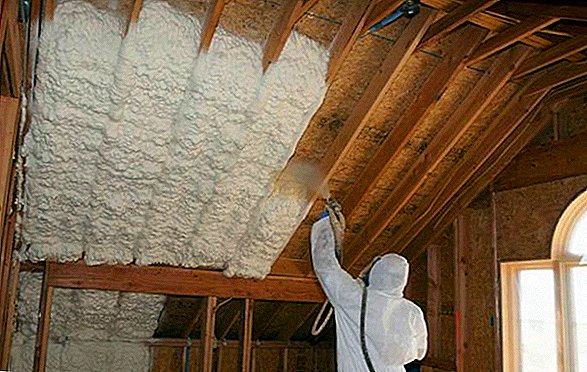
- eco-friendly;
- cotton fabric;
- ecowool.


These materials do not affect the health of residents, almost do not contain chemical fibers and do not emit toxic substances during combustion. At the same time, they have excellent air permeability, heat and sound insulation. However, insulating the roof with materials with such characteristics, you must be ready to lay out a substantial amount.
To arrange the interior of the house, we recommend learning how to install a light switch, do it yourself and install a flowing water heater, as well as remove old paint and whitewash, whiten the ceiling and glue the wallpaper, how to make a plasterboard partition with a doorway or sheathe the walls with plasterboard.
The role of natural insulation can also perform sawdust, algae, straw, granulated paper.
When insulating it is very important to choose the thickness of the insulation layer.

It will depend on the following factors:
- the climate in which the house is built;
- wall thickness;
- height of the roofing pie.
Did you know? In Russia, penthouses as living quarters were popular from the 18th to the beginning of the 20th century. They were called mezzanines, gorenki, fireside. Since the 20s, after straight-roofed houses came into vogue, the attic apartments have been forgotten. And only at the end of the last century, they again interested architects and property buyers.
Mansard roof insulation technology
Let's take a closer look at the technology of external and internal insulation of the roof of the attic type.
External insulation
Warming outside involves the use of foam plastic or expanded polystyrene. It is done directly during the construction of the house or after updating the leaky roof. The roofing pie is laid in this way:

- 1st layer - expanded polystyrene plates;
- 2nd layer - waterproofing membrane;
- 3rd layer - purlin with ventilation gaps;
- 4th layer - roofing material.
For arranging the territory of a private house, you probably recommend you to read about how to build a cellar with ventilation, a sheepfold, a chicken coop, a veranda, and also to make a gazebo, garden swing, bench, pergola, barbecue, fence with your own hands.
Interior
Internal warming can be divided into several stages:
- Preparation for attaching insulation material.
- Laying insulation.
- Fastening heat insulator.



Insulation (mini wool) will need to be attached to the cells between the rafters. It is cut into pieces 3-4 cm longer than the distance between the rafters. It is necessary to lay it, starting from the bottom edge of the roof, butt.
To create a ventilation space to remove excess moisture, you need to fasten the heat insulator with self-tapping screws to the rafters of the wooden counter rail.
On top of the rafters you need to put another thin layer of insulation. On top of the insulation (in case it is cotton) there is a vapor barrier film, the joints of which are sealed. Next, the structure is attached with a batten, and reflective insulation is performed. After that, you can begin to finish the ceiling. The most common materials for finishing - fiberboard, plywood. Additional sound insulation will help create a suspended ceiling.
Thus, with internal warming, the roofing pie will look as follows:

- 1st layer (bottom) - finish;
- 2nd layer - purlin with a ventilation gap;
- 3rd layer - vapor barrier film;
- 4th layer - insulation in two layers;
- 5th layer - waterproofing membrane;
- 6th layer - ventilation gap with crate;
- 7th layer - roofing material.
To keep warm in your home. We advise you to learn how to warm the window frames for the winter and choose a heating stove
How to additionally insulate with expanded polystyrene
In some cases, in order to achieve better thermal insulation, two types of insulation are used. So, mineral wool is laid between the rafters, and the truss system is sewn up with polystyrene foam.

However, with such a warming there is a risk that water vapor entering the mineral wool will not find a way out due to the airtightness of expanded polystyrene and will create favorable conditions for the development of mold. Therefore, experts advise: if you decide to use two different types of insulation, then at the beginning, after waterproofing, lay an inhale expanded polystyrene on the bottom of the rafters, and below - a mineral wool.
Important! In case of high-quality combined warming of the roof of the attic type, it is necessary to use the rule: the upper layer of insulation must have higher vapor permeability and thermal conductivity than the lower one.
How to care for the roof and its constituent materials
The roof, no matter how well built and properly built, requires care. For it to serve for a long time, it is necessary to regularly carry out preventive measures, which include:
- visual inspection once a year, better in spring, with checking the condition of components, coating, curtain edges;
- cleaning at any time of the year (from snow, branches, dirt, moss, lichen), preferably twice a year, including drainage systems.

Features care for the roof will depend on the material with which it is covered. Metal and soft tiles need only be periodically cleaned with a high-pressure washer and soft brush. Also need careful cleaning from the snow, if it does not come down for a long time.
The roof of the Shinglas is cleaned of snow and ice, check the reliability of hooks for stepladders, seams and abutments. Wash it once every four to five years. Ceramic tile does not require additional efforts to care, you need only time to clear the snow and branches.
Slate brushed with a metal brush from moss and lichen. For the prevention of antiseptic solution applied.
Did you know? The progenitress of modern shingles can be called a clay cake, burned in the sun. Such a roof was discovered during excavations of ancient Egyptian settlements.
Ondulin should be examined twice a year, in May and October. Onduline roof must be cleaned in the fall of the leaves, and in the spring - from debris accumulated under the snow. It is important to ensure that the roof is not scratched by the branches of trees growing near it. A drainage system survey is also required.
The repainting time will depend on the roofing, since each of its appearance has a different service life. The period of staining is determined individually for each house.

In conclusion, we note that homes with mansards are increasingly attracting the attention of those who are choosing a new home. This interesting architectural solution, of course, contributes to the construction of the building, making it original, distinguished from others. In addition, interesting and planning attic in the middle. However, in order to live comfortably in a room under the roof, it is necessary to take care of its heat and waterproofing.
You can warm the attic roof with your own hands. With properly equipped ventilation and correctly selected modern high-quality insulating material, as well as with the observance of the building recommendations for the roofing pie, it will not be difficult.
Reviews from the Internet
Пирог кровли должен быть : - кровельное покрытие с вентэлементами у конька - обрешётка, - контррейки !!! (проветривание кровли) толщины мин. 4 см - Ваше гидрозащита склеена непосредственно на стропилах - утеплитель - минвата или стеклована общей толщины мин. 160 mm (if its lambda is not greater than 0.04 W / m2.K) - vapor barrier (Yutafol N 110 film connected with Yutafol SP tapes) - strips or profiles for the ceiling with insulation - mineral wool or glass fiber of total thickness 40 mm (if its lambda is not greater than 0.04 W / m2.K) - ceiling board

The total amount for the labor and materials: 112.000r. The cost of kW / m is 750r.
If you use PPU, then the cost per kV / m is 1250r. The difference is 500r per kV / m. On the whole roof, the difference is 75000r against the general background of building a house, in my opinion this amount is not large (I think over the long years of living in this house, the cost of heat compensates for these costs.). Yes, and the materials taken for the first calculation are some of the cheapest, and if you take better materials then the difference in kW / m between both options will be even less !!
While my decision is in favor of PPU

Yes, talk about the fact that a neighbor's slate roof without any heaters and films is 100 years old, not rolled, because the attic with slots has strong drafts, which will not be the case if the attic is being insulated. There is still a vyvidyd providing full ventilation of the roofing space.



